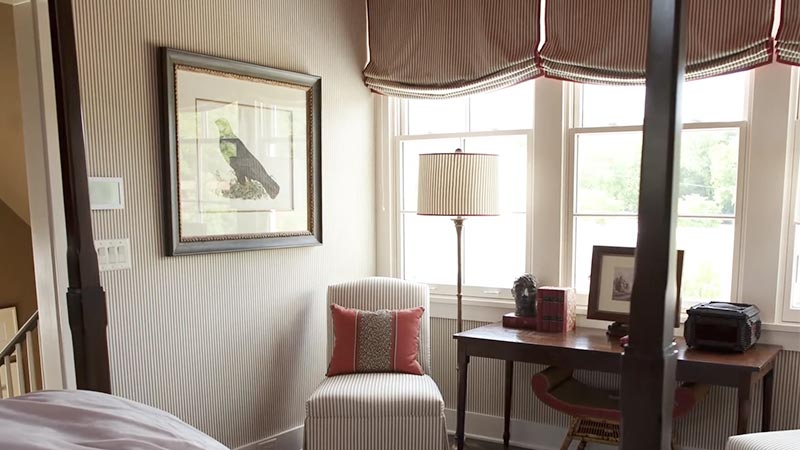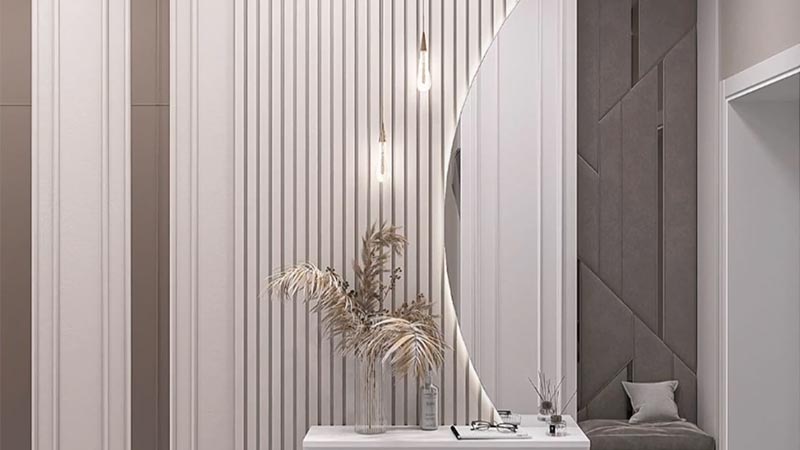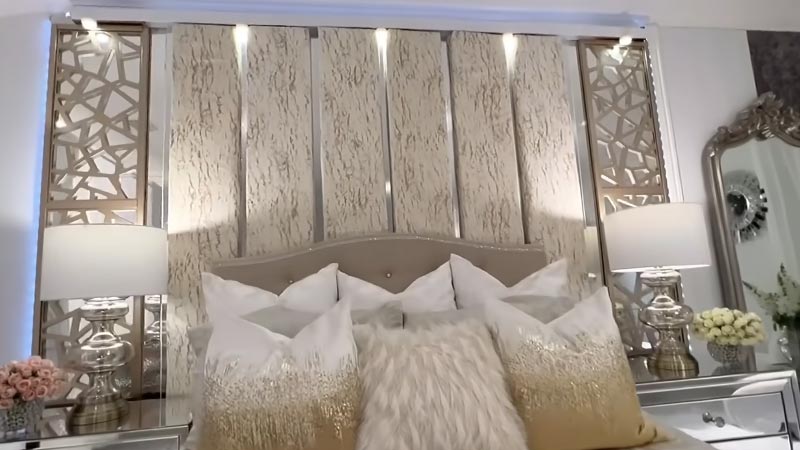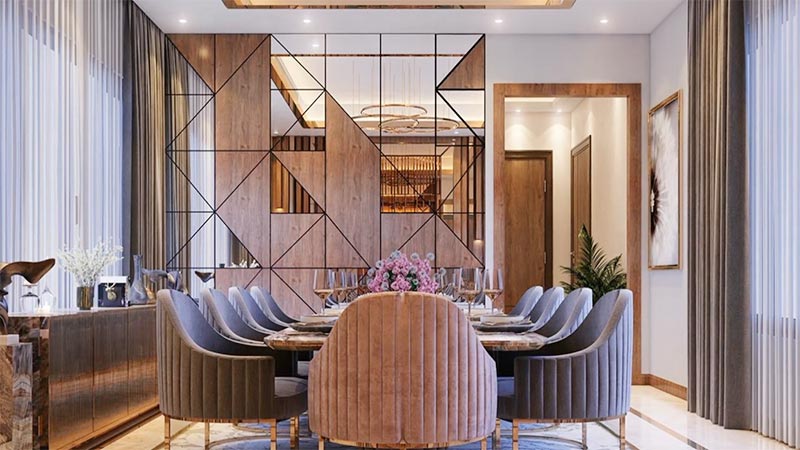Transforming a mirrored wall with fabric is a captivating DIY project that infuses warmth, character, and personalized style into any space.
This creative endeavor offers a unique opportunity to revamp your interior, whether you’re looking to mask imperfections, reduce glare, or add a touch of elegance.
By carefully selecting the right fabric and employing the appropriate techniques, you can create a visually striking focal point that complements your existing décor.
This step-by-step guide will walk you through the process, ensuring a seamless and visually stunning outcome that breathes new life into your mirrored wall. Embark on this journey to redefine your living space with fabric-covered allure.

How to Cover a Mirrored Wall With Fabric?
Covering a mirrored wall with fabric can transform a space and add a touch of elegance and warmth to your room.
Whether you’re looking to hide an outdated mirrored wall or want to create a unique decorative element, this project can be a fun and creative way to revamp your interior.
Here’s a step-by-step guide on how to cover a mirrored wall with fabric:
Materials You’ll Need:
- Fabric.
- Measuring tape and pencil.
- Scissors.
- Staple gun.
- Staples.
- Level.
- Adhesive or double-sided tape.
Step-by-Step Guide:
Measure the Wall
Begin by ensuring a clear and unobstructed view of the mirrored wall. Remove any decorations or furniture that might get in the way. Use a sturdy measuring tape to get precise measurements.
Start from one corner and extend the tape measure all the way to the other end of the wall.
Take both the height and width measurements. Write down these measurements in a notebook or on a piece of paper, and double-check them to ensure accuracy.
Select and Prepare Your Fabric
Lay your chosen fabric on a clean, flat surface. Using a large table or the floor for this step is a good idea. Smooth out any wrinkles or folds in the fabric to ensure accurate measurements.
You can use an iron on a low setting to remove any stubborn creases, but be cautious if your fabric is delicate.
Mark the dimensions according to your measurements using a fabric-friendly pencil or chalk. Cutting a bit larger than needed is better, as you can always trim excess fabric later.
Cut the Fabric
Following your marked lines carefully cut the fabric with sharp scissors. Take your time to ensure clean, straight cuts.
When your wall is particularly tall, you might need to join two pieces of fabric together. In this case, ensure the pattern aligns seamlessly, and sew or fuse the pieces as necessary.
Step 4: Position the Fabric:
Begin by securing the top edge of the fabric. You might want to use a temporary adhesive or tape to keep it in place while you’re attaching it to the wall.
If your fabric has a specific pattern, start from a corner that allows for the best alignment of the pattern across the entire wall.
Attach the Fabric
Use a staple gun to attach the fabric. Start at one corner and work your way across the top edge. Space the staples about an inch apart to ensure even coverage.
Pull the fabric taut as you staple it, but be careful not to overstretch it, which can lead to distortion.
Work down one side of the wall, stapling as you go. Pull the fabric tight each time you add a staple to prevent sagging. Repeat the process for the other side and staple along the bottom edge.
Check and Adjust
Periodically step back to assess your progress. Ensure the fabric is straight, smooth, and free of wrinkles or bubbles.
When you notice any issues, gently remove staples using a staple remover or pliers, and readjust the fabric as needed. It’s better to take your time and get it right.
Secure with Adhesive
Applying double-sided tape or adhesive along the edges before stapling can provide additional security and support when using a lightweight or delicate fabric.
Trim Excess Fabric
Once the fabric is securely attached and you’re satisfied with the placement, use sharp scissors to trim any excess fabric along the edges. Take care not to cut too close to the staples.
Finishing Touches
When there are seams where two pieces of fabric meet, consider adding decorative trim, ribbon, or fabric glue to cover the seam for a polished, cohesive look.
Enjoy Your New Wall
Step back and take in the transformation! Admire how the fabric has added a soft, personalized touch to your space. Arrange furniture and decorations to complement the new look of your wall.
Why Would You Want to Cover a Mirrored Wall With Fabric?

Covering a mirrored wall with fabric can be a strategic and aesthetically pleasing choice for various reasons.
This creative endeavor offers a unique opportunity to personalize your living space, creating a warm and inviting atmosphere that reflects your individual style.
Here are some compelling reasons why one might choose to embark on the endeavor of draping a mirrored wall with fabric:
Enhancing Aesthetic Appeal
Mirrored walls, though functional, can sometimes exude a cold and impersonal ambiance. By adorning it with fabric, you introduce a softness and warmth that is both visually pleasing and inviting.
The fabric’s texture, pattern, and color can complement the room’s decor, providing a cohesive and harmonious look.
Concealing Imperfections
Mirrored surfaces can show signs of wear, such as scratches, marks, or aging effects. The fabric serves as an excellent concealer, effectively masking these imperfections.
It offers a simple yet effective solution to refresh and revitalize the space without resorting to costly renovations.
Reducing Glare and Reflections
In rooms with abundant natural light or intense artificial lighting, mirrored walls can sometimes create excessive glare or reflections.
Adding fabric helps diffuse light, creating a more comfortable and balanced environment. This is particularly beneficial in spaces where glare can be distracting or uncomfortable.
Personalizing the Space
The fabric allows for a wide range of customization. You can choose from an extensive array of colors, patterns, and textures, enabling you to craft a space that resonates with your unique taste and personality.
This personal touch can significantly affect how you experience and connect with the room.
Sound Dampening
Mirrored surfaces can sometimes amplify sounds, contributing to an echoey or noisy environment. By layering fabric over the mirror, you introduce an element of sound absorption, effectively dampening echoes and creating a more acoustically comfortable space.
Versatility in Design
Fabric offers endless design possibilities. From rich, opulent textures to light, airy patterns, the choice of fabric can completely transform the room’s character.
Whether you aim for a cozy, intimate atmosphere or a vibrant, energizing space, fabric provides a versatile canvas to achieve your desired effect.
Temporary or Rental Solutions
Fabric is ideal for those in rental spaces or looking for a non-permanent solution.
It can be applied without causing damage to the mirror surface and can easily be removed or replaced, allowing for flexibility in design choices.
Alternative Ways to Cover a Mirrored Wall With Fabric

Aside from directly attaching fabric to the mirrored wall, there are alternative methods to achieve a similar effect.
Here are three alternative ways to cover a mirrored wall with fabric:
Fabric Panels
Create fabric-covered panels that can be mounted on the wall. This involves framing sections of fabric with wooden or metal borders, similar to how you’d frame a painting or a piece of artwork.
The framed fabric panels can then be securely hung on the mirrored wall, creating a decorative and customizable design.
Fabric Wall Decals
Explore adhesive fabric decals or stickers. These are easy-to-apply, removable fabric sheets with adhesive backing. They come in various designs, patterns, and textures.
Arrange and stick them directly onto the mirrored surface, covering it with a fabric-inspired design. This option allows for flexibility and easy removal, making it suitable for temporary or rental spaces.
Fabric Drapery
Install a fabric drapery system in front of the mirrored wall. This involves attaching a curtain rod or track on the wall above the mirror and hanging fabric panels or curtains that can be drawn open or closed.
This method covers the mirrored surface and adds an elegant and dynamic element to the room.
Care for the Fabric on the Mirrored Wall

Caring for the fabric on your mirrored wall is essential to maintain its beauty and longevity. Proper maintenance ensures that your fabric remains in excellent condition, continuing to enhance the aesthetics of your space.
Here are some tips on how to care for the fabric on your mirrored wall:
Regular Dusting and Vacuuming
Dust can accumulate on fabric over time, dulling its appearance. Use a soft brush attachment on your vacuum cleaner to gently remove surface dust.
When your fabric has a textured or patterned surface, take extra care to get into crevices and grooves where dust may settle. For delicate fabrics, consider using a lint roller to remove any particles without causing damage.
Spot Cleaning
Accidents happen, and it’s important to address spills or stains promptly to prevent them from setting in. Start by blotting the affected area with a clean, white cloth or sponge. Avoid rubbing, as this can spread the stain.
Use a mild detergent or fabric cleaner that is appropriate for your fabric type. Always test the cleaning solution on an inconspicuous area first to ensure it doesn’t cause any discoloration or damage.
Avoid Harsh Chemicals
Resist the temptation to use harsh chemicals or solvents on your fabric. These substances can weaken the fibers, alter the color, or cause other forms of damage.
Stick to gentle, fabric-friendly cleaners and follow the manufacturer’s recommendations for cleaning.
Professional Cleaning
When your fabric requires specialized care or if you’re uncertain about how to clean it safely, consider consulting a professional cleaning service. They have the expertise and equipment to clean delicate fabrics without causing harm.
Prevent Sun Damage
Direct sunlight can cause colors to fade over time. Consider using curtains, blinds, or window films to filter or block out UV rays during the sunniest parts of the day. This simple measure can go a long way in preserving the vibrancy of your fabric.
Protect from Pets and Sharp Objects
Pets, especially those with sharp claws, can inadvertently damage fabric surfaces. Take precautions to keep pets away from the fabric or provide designated areas where they can play without coming into contact with it.
Additionally, avoid placing sharp or heavy objects against the fabric, as they can cause tears or other forms of damage.
Handle with Clean Hands
Oil and dirt from your hands can transfer onto the fabric, potentially causing stains or discoloration.
Wash your hands thoroughly before handling the fabric, especially if you’ve been working with any substances that could potentially harm it.
Check for Loose Threads
Examine the fabric periodically for any loose threads or fraying edges. If you notice any, use small, sharp scissors to trim them carefully. Taking care of loose threads promptly can prevent further unraveling and maintain the integrity of the fabric.
Avoid Abrasive Surfaces
Be mindful of any surfaces that may come into contact with the fabric. Avoid placing abrasive materials or objects against it, as they can cause snags or tears.
Consider using protective covers or pads on surfaces that frequently interact with the fabric.
Consider Fabric Protection Products
Fabric protection sprays or treatments can provide an extra layer of defense against spills and stains. Follow the manufacturer’s instructions for application carefully.
Remember that these products may need to be reapplied periodically, so be sure to check the label for any recommended maintenance.
Keep Pets Away
When you have pets, especially those known to be curious or playful, consider using deterrents or barriers to keep them away from the fabric.
This proactive measure can help prevent potential damage from scratching, chewing, or other playful activities.
FAQs
Is it possible to remove the fabric later if I want to revert to the mirrored wall?
Yes, with proper installation techniques, the fabric can be removed without causing damage to the mirrored surface.
What type of fabric works best for this project?
Medium-weight fabrics like cotton, linen, or upholstery fabrics are generally recommended. Choose a fabric that complements your décor and is easy to work with.
Can I apply fabric directly onto the mirror, or should I prepare the surface anyway?
It’s generally recommended to avoid applying fabric directly onto the mirror. Instead, consider using a light adhesive, double-sided tape, or attaching the fabric to a frame or panels.
How do I address seams or joins in the fabric if my wall is larger than the fabric width?
You can strategically place seams in less conspicuous areas or use fabric glue or a sewing technique to join pieces together seamlessly.
What’s the best way to clean and maintain fabric-covered mirrored walls?
Regular dusting and spot cleaning are effective. Avoid using harsh chemicals and opt for mild detergents.
Wrap Up
Adorning a mirrored wall with fabric is a transformative endeavor that brings a personal touch to your living space. The careful selection of fabric, meticulous installation, and thoughtful maintenance culminate in a striking visual impact.
Whether it’s to add warmth, mask imperfections, or infuse a room with your unique style, this project offers a versatile solution. The result is a space that feels inviting, harmonious, and distinctly yours.
With the right fabric and attention to detail, you can achieve a seamless integration that elevates the aesthetics of your interior. Embrace the creativity and embark on this journey to create a fabric-covered sanctuary.
Leave a Reply